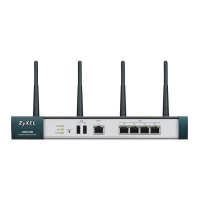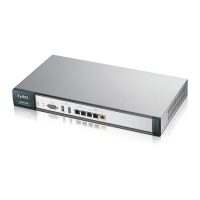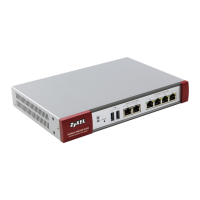Chapter 22 User/Group
UAG CLI Reference Guide
159
22.2.3.1 User Setting Command Examples
The following commands show the current settings for the number of simultaneous logins.
22.2.4 Web Authentication Policy Commands
This table lists the commands for forcing user authentication.
Router# configure terminal
Router(config)# show users simultaneous-logon-settings
enable simultaneous logon limitation for administration account: yes
maximum simultaneous logon per administration account : 1
enable simultaneous logon limitation for access account : yes
maximum simultaneous logon per access account : 3
Table 86 username/groupname Commands Summary: Web Authentication Policy
COMMAND DESCRIPTION
[no] web-auth activate Enables force user authentication that force users to log in to the UAG
before the UAG routes traffic for them. The no command means the user
authentication is not required.
web-auth default-rule authentication
{required | unnecessary} {no log | log
[alert]}
Sets the default authentication policy that the UAG uses on traffic that does
not match any exceptional service or other authentication policy.
required: Users need to be authenticated. They must manually go to the
UAG’s login screen. The UAG will not redirect them to the login screen.
unnecessary: Users do not need to be authenticated.
no log | log [alert]: Select whether to have the UAG generate a log
(log), log and alert (log alert) or not (no log) for packets that match
this default policy.
web-auth [no] exceptional-service
service_name
Sets a service which you want users to be able to access without user
authentication. The
no command removes the specified service from the
exceptional list.
web-auth login setting Sets the login web page through which the user authenticates his or her
connection before he or she can then connect to the rest of the network or
Internet. See Table 87 on page 160 for the sub-commands.
web-auth policy <1..1024> Creates the specified condition for forcing user authentication, if necessary,
and enters sub-command mode. The conditions are checked in sequence,
starting at 1. See Table 88 on page 161 for the sub-commands.
web-auth policy append Creates a new condition for forcing user authentication at the end of the
current list and enters sub-command mode. See Table 88 on page 161 for
the sub-commands.
web-auth policy insert <1..1024> Creates a new condition for forcing user authentication at the specified
location, renumbers the other conditions accordingly, and enters sub-
command mode. See Table 88 on page 161 for the sub-commands.
web-auth policy delete <1..1024> Deletes the specified condition.
To modify a condition, you can insert a new condition (N) and then delete
the one (N+1) that you want to modify.
web-auth policy flush Deletes every condition.
web-auth policy move <1..1024> to
<1..1024>
Moves the specified condition to the specified location and renumbers the
other conditions accordingly.
show web-auth activation Displays whether forcing user authentication is enabled or not.
show web-auth default-rule Displays settings of the default web authentication policy.

